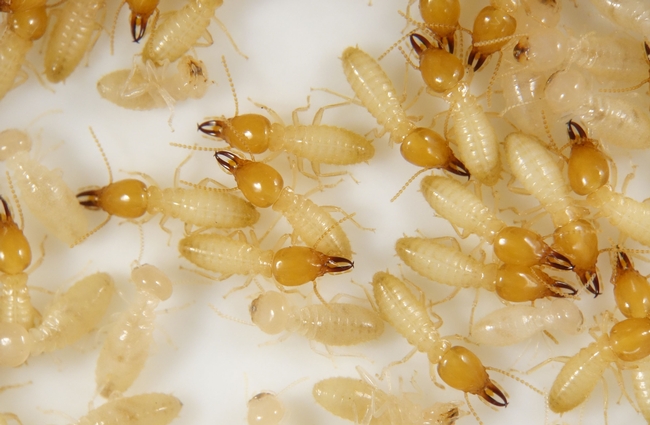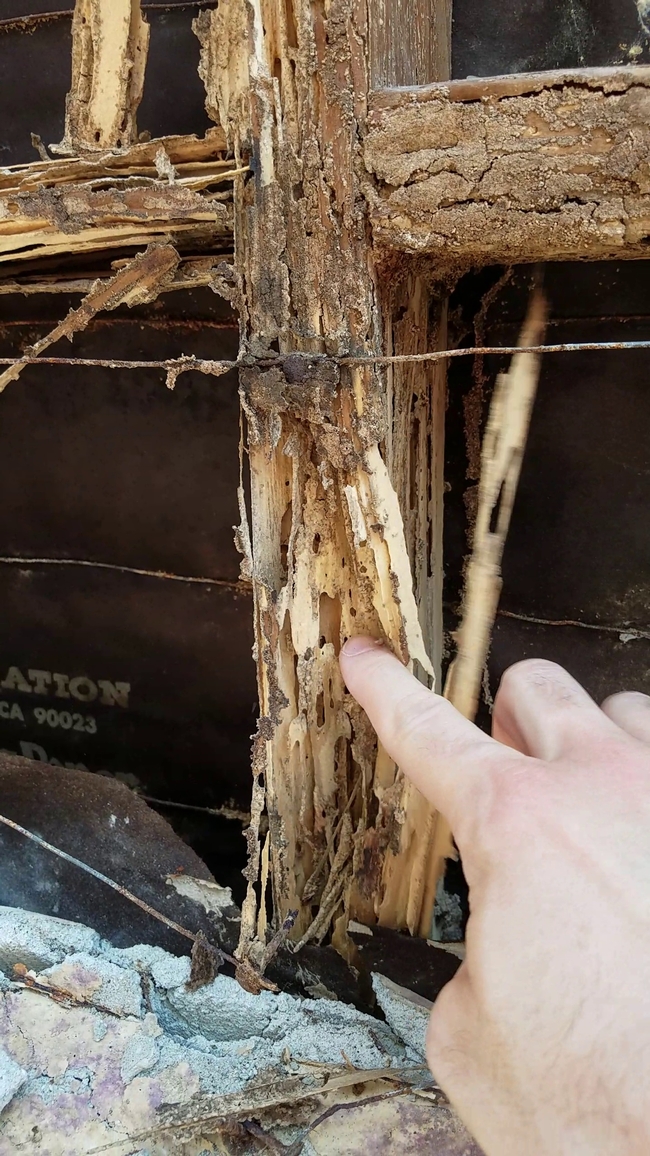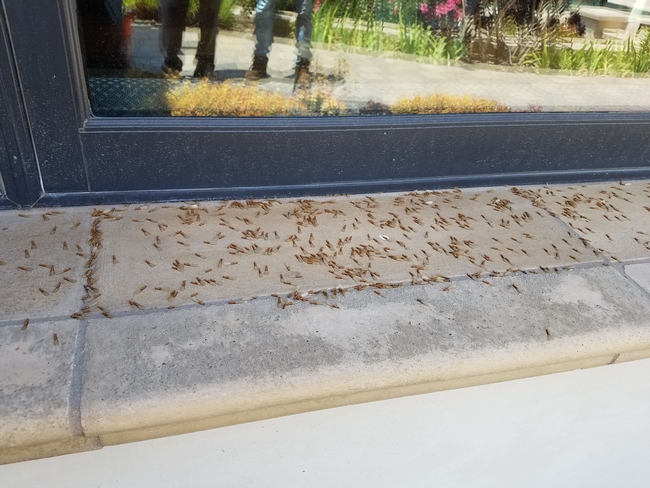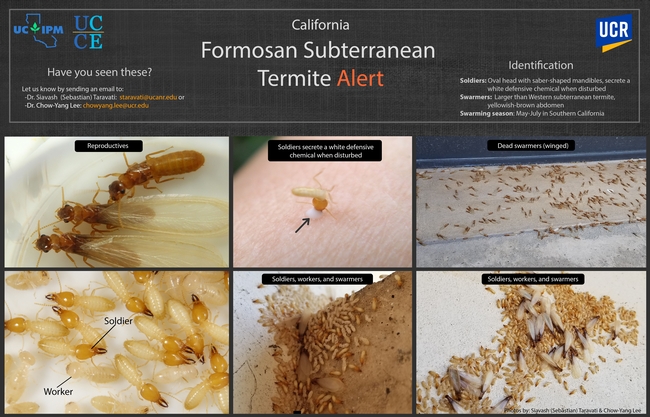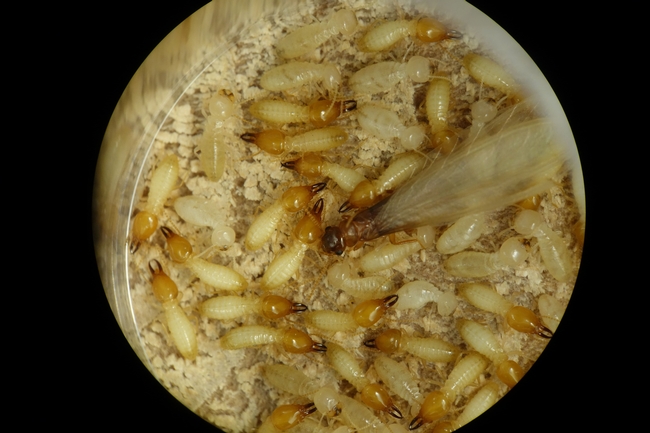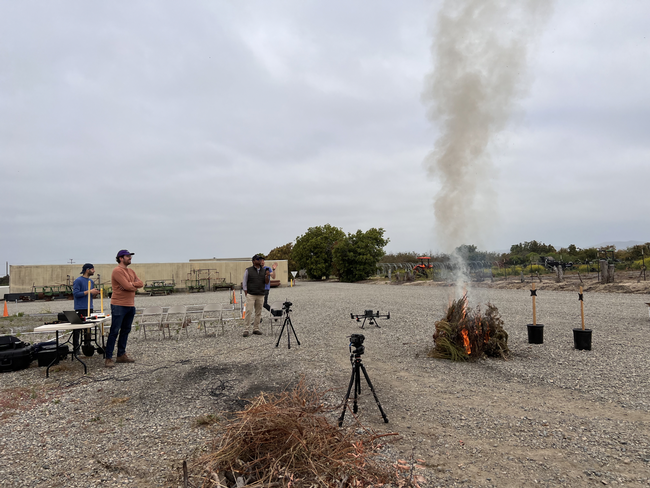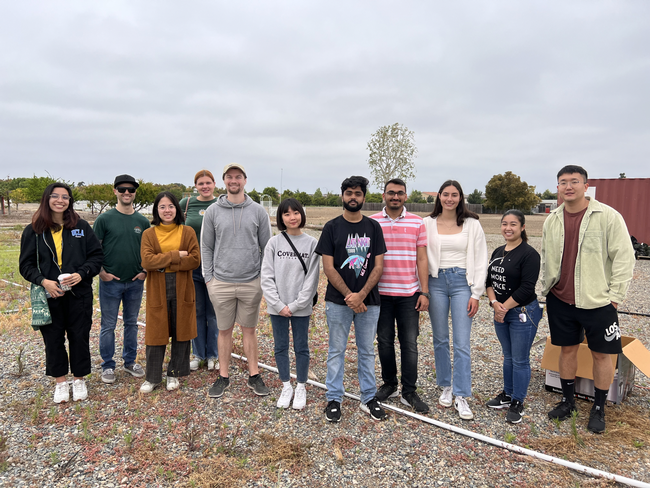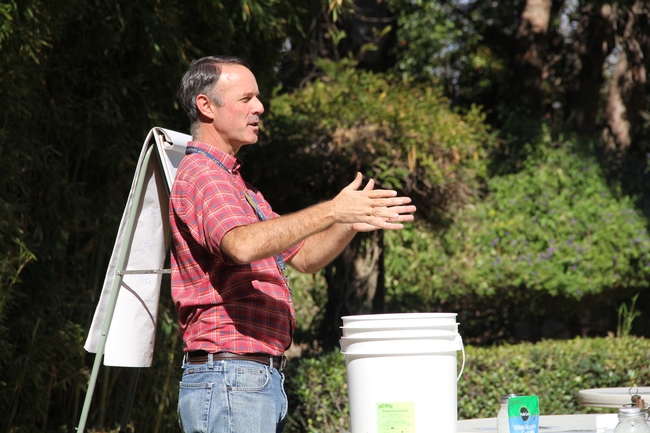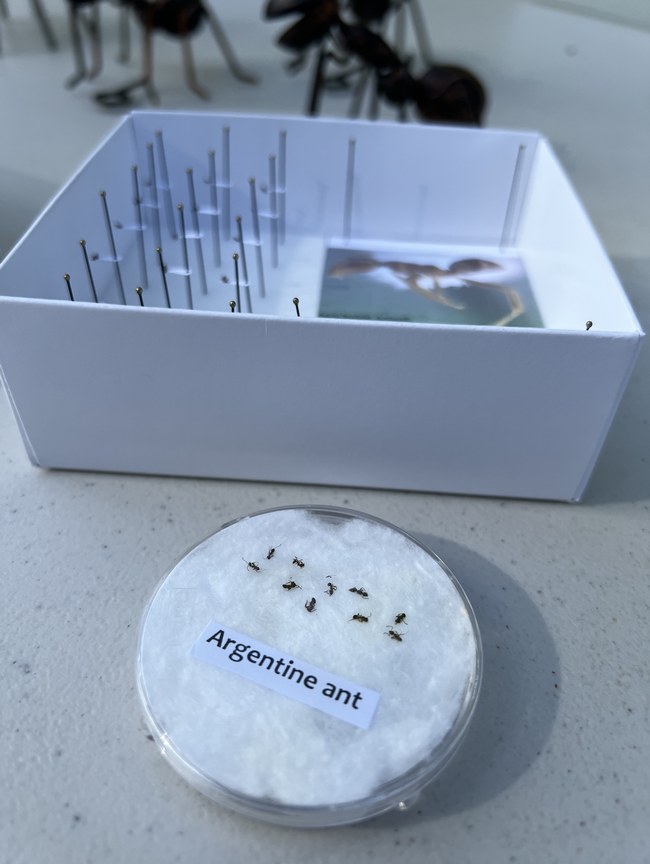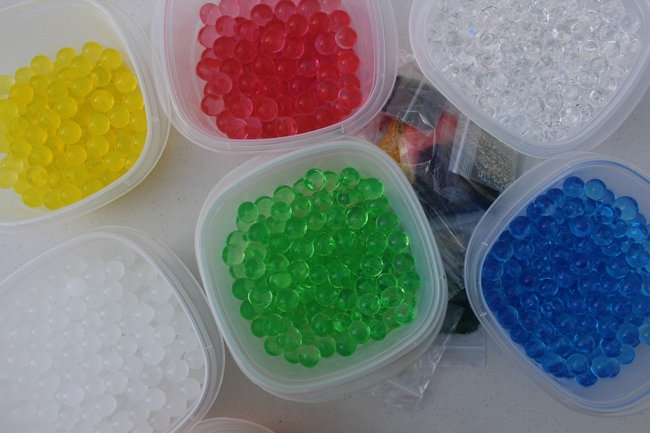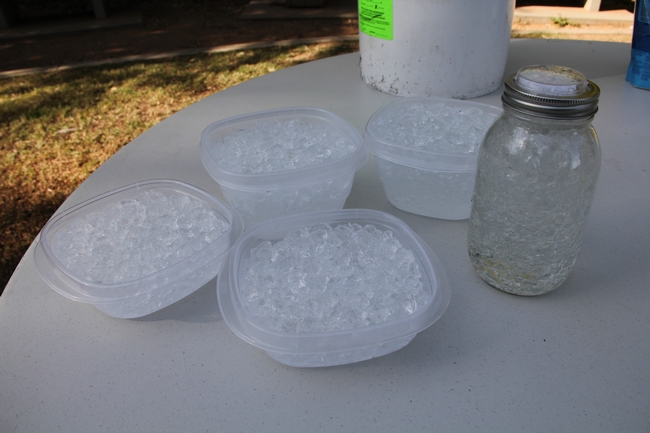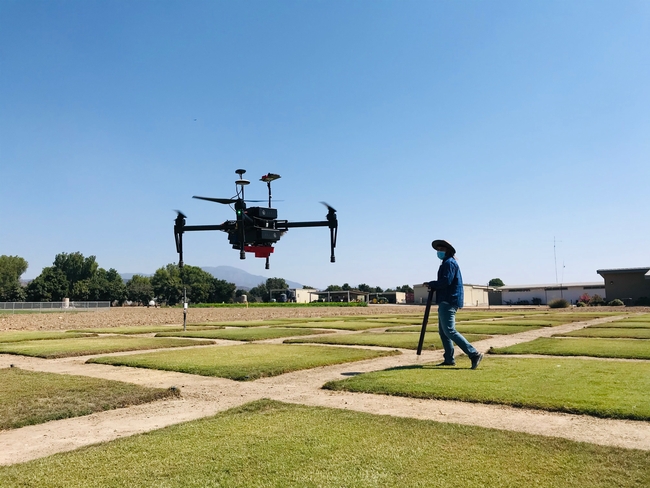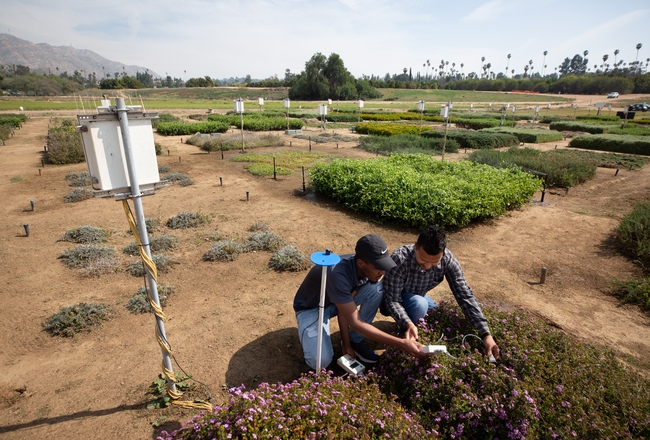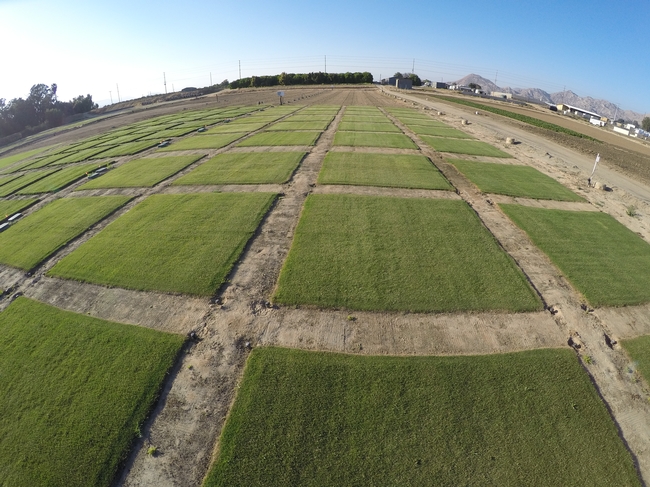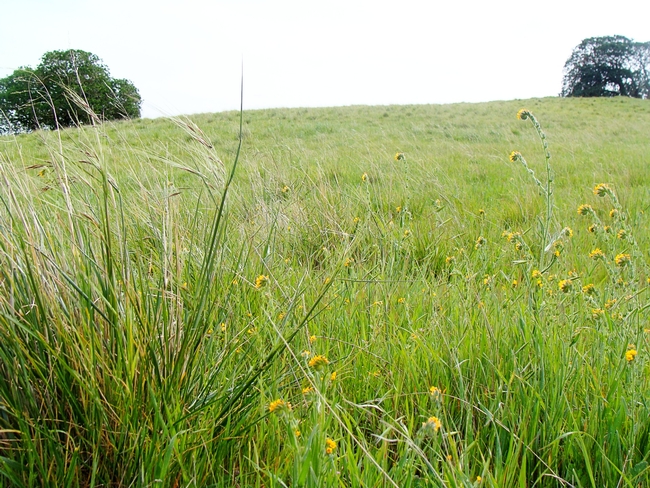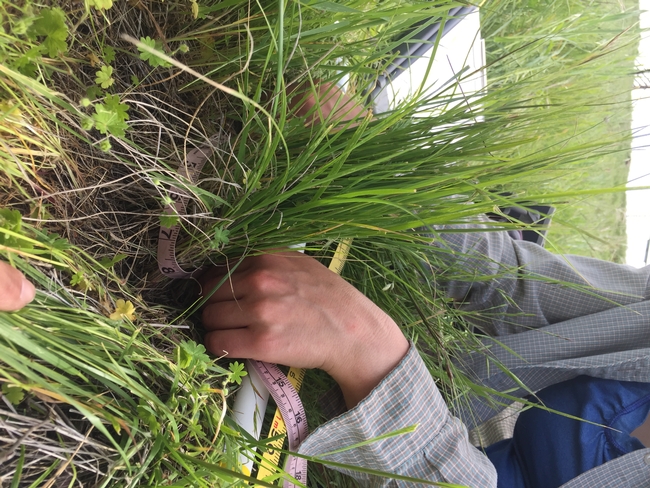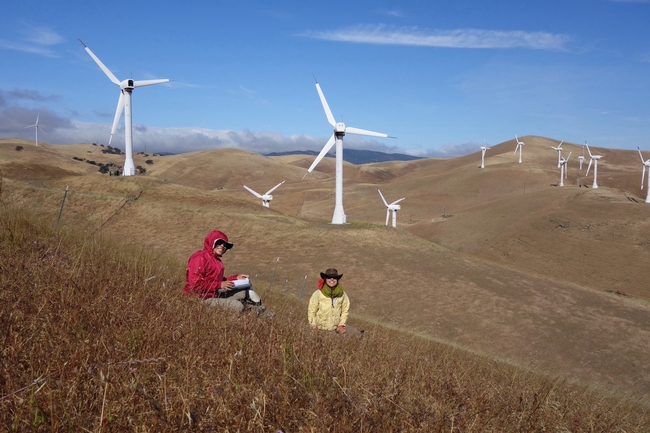Posts Tagged: Riverside
Cooperative Extension advisor, UC experts tackle ‘nightmare’ termite
During summer swarming season, homeowners urged to check for signs of Formosan subterranean termite
In the lottery of troublesome termite infestations, “Roger,” a Rancho Santa Fe homeowner, hit the jackpot (a pseudonym is used to protect his privacy). In 2021, his house in San Diego County was identified as home to only the fourth documented colony of the Formosan subterranean termite (Coptotermes formosanus) in California.
“FST is one of the most destructive urban pests in the world,” said University of California, Riverside entomologist Chow-Yang Lee, affiliated with UC Agriculture and Natural Resources through the campus' Agricultural Experiment Station. “It's also the only termite species listed in the ‘100 of the World's Worst Invasive Alien Species.'”
Endemic to East Asia, this termite is now established in many tropical and subtropical regions, including across the American South. Annually, its infestation costs more than $4 billion in control measures and damage repairs of structures in the U.S.
FST was first discovered in California in La Mesa (San Diego County) in 1992, and it was rediscovered in that city in 2018. Another infestation was reported in Canyon Lake (Riverside County) in 2020. And then, the following year, Roger received his surprise.
“Imagine being in your kitchen looking at your drywall and it's totally normal and then the next day there's a four-inch hole there and you're like ‘What the heck is that? Who put their elbow into the drywall?'” he recalled.
FST colonies can reach millions of individuals
Roger hired a pest control company, Green Flash Pest Control, which sprayed a powerful liquid termiticide in the soil around the house. But the termites – workers, soldiers and winged “alates” – continued to appear. The company tried a second application of soil treatment. But, again, the termites kept popping up.
“We were deeply concerned about the potential damage these termites could cause to the home since these invasive termites are extremely destructive,” said Eric Veronick, director of operations at Green Flash. “Unfortunately, there isn't a whole lot of information available on the behavior and management of this termite in California.”
The company called upon Siavash Taravati, a UC Cooperative Extension urban Integrated Pest Management (IPM) advisor based in Riverside.
“Some colonies are aerial, meaning that they are formed above the ground with limited or no connection to the soil – in such cases, soil treatment using contact insecticides may not be very effective in managing these termites,” Taravati said. “Furthermore, contact insecticides usually kill a much smaller portion of the colony when compared to termite baits.”
To make matters worse, once FST is established in an area, there have been no records of successful eradication anywhere in the world, according to Taravati. He added that a major reason why the Formosan subterranean termite is so destructive is the enormous size of their colonies.
“Their colonies can reach millions of individuals, versus most native subterranean species that reach a few hundred thousand individual termites per colony,” Taravati explained.
This termite, through its sheer numbers, can turn the wood in a structure into a “spongy kind of cake,” in Taravati's words. More than 10 pounds of wood in a house can be eaten by a mature colony each month. The financial hit for a homeowner can be substantial, up to tens of thousands of dollars – not to mention the increased risks to safety.
“Anything from studs to rafters to door frames and window frames – everything is going to be compromised, if the termites are left unchecked. And then, as soon as we have a major stress on the building, let's say there's a big storm or an earthquake – there's a high risk of at least part of the building collapsing,” said Taravati, who also noted that, unlike California native subterranean termite species, FST can attack and kill live trees and plants.
“These termites can be a nightmare,” he said.
Summer is ‘swarming season' for FST
Since the Rancho Santa Fe case in 2021, four more colonies have been documented, in La Mesa again and also in Highland Park, Hollywood Hills and La Verne (the latter three in Los Angeles County). Taravati said it's possible that FST has been spreading via structural lumber or potted plants and soil.
And even if a colony appears to be eliminated at a certain locale, Taravati noted, there is always the chance that part of the colony survives or more colonies of termites already have been established in nearby locations, as a result of swarming termites from the originally infested property.
Although nominally “subterranean,” certain members of an FST colony grow wings and fly to nearby locations to establish new colonies. These winged alates are also called swarmers because of their behavior during the “swarming” season, when termites mate and reproduce.
For the Formosan subterranean termite, that swarming season in California is late May through early August, so now is the time for homeowners and building managers in southern and central California to keep an eye out for those winged termites.
“If you experience a termite swarm in your house, contact a pest management professional and keep some termite samples in a Ziploc bag in the event you need to send the samples to UC Riverside for morphological and DNA-based identifications,” said Lee, who added that it's a good idea to periodically check your structure for signs of infestation, such as wood damage or shelter tubes (mud tubes).
Lee said FST swarmers have a lighter colored body compared to the dark color of native subterranean termites and the orange-brown body of drywood termite swarmers (see this flyer for additional identification information).
Following an especially wet winter, there's a chance California could see more FST infestations, as this termite generally requires moist environments to thrive, Lee added. He recommends that concerned community members seek professional advice.
“Do not attempt to control an FST infestation by yourself,” Lee said. “This is not your typical native Californian subterranean termite species; they are highly destructive, and you want to intercept the problem with the right strategy before it's too late.”
Homeowner: ‘I owe them my house'
In Roger's case, Taravati enlisted the help of Lee and his UC colleague, Greg Kund. They made multiple visits to inspect the home and analyze the situation – going “above and beyond,” according to Roger.
At Lee's suggestion, they used a caulk gun to insert a gel-like experimental bait into the wall where the termites were coming out. Once spread and passed on to the other nestmates, the product – which contains a chitin synthesis inhibitor (a type of insect growth regulator) – interrupts the termites' development so they are unable to properly molt and replace the short-lived “workforce” of foragers and soldiers. The colony eventually collapses and is eliminated.
“Generally speaking, IGRs are much more effective, but they require more patience,” Taravati explained. “You're not going to see the results the next day, or two-three days. You're going to see the results in a few weeks – but when you see the results, it's massive.”
And that's exactly what Roger and Green Flash Pest Control saw.
“Soon after their bait application, the termites stopped emerging from the walls and that gave us and the homeowner a big sigh of relief,” Veronick said. “I appreciate their expertise and dedication in helping us get rid of this destructive pest."
Roger said he is immensely grateful to the UC team.
“They were fantastic; I owe them my house,” he said. “They were super gracious and helpful and responsive and – ultimately, the thing I care most about – they were effective; they fixed the problem. Here we are two years later and – knock on wood, or maybe I should knock on something else! – everything is good.”
Lee also credited Taravati for bringing his knowledge and “can-do” attitude to communities across Southern California.
“He is highly knowledgeable and always able to come up with feasible solutions,” Lee said. “We need good Cooperative Extension urban IPM advisors like Siavash who could provide good advice and bring solutions to the stakeholders, be they homeowners or pest management professionals.”
Taravati said community members need to maintain their vigilance and urges them to download and share the FST flyer that includes identification tips and contact information. He said they are always free to e-mail him with their concerns and photos of suspected FST – not only to help stop the spread of the pest but to expand scientific understanding.
“This termite is so new to California – even for us, as researchers. Despite being in La Mesa since the 1990s, it wasn't until 2020 when these termites were detected in other places, including Riverside and Los Angeles counties,” Taravati explained. “All of us need to learn more about this pest and closely monitor the behavior of this pest.”
Cooperative Extension fire advisor and UC graduate students gather around the fire
Besides starting fires for the sake of research, Luca Carmignani, UC Cooperative Extension fire advisor for San Diego, Orange, Los Angeles, and Riverside counties, has started leveraging his connection to local UC campuses by providing opportunities for hands-on learning.
Early one morning in May, students and staff from UC Irvine and UC Riverside gathered at the South Coast Research and Extension Center to collect data for their own research projects. South Coast REC, located in Irvine, is part of a statewide network of research and education facilities operated by UC Agriculture and Natural Resources.
In one area of the field, graduate students picked leaves and twigs from dried shrubs, carefully placing them in a device that measures moisture content. In another area, a postdoctoral scholar set up a device that records levels of particulate matter, carbon dioxide and other air pollutants emitted by a fire.
Tirtha Banerjee, professor in the Department of Civil and Environmental Engineering at UC Irvine, coordinated the field day with Carmignani. The two first connected as members of iFireNet, an international network of networks that connect people to fire research, when Carmignani was a postdoctoral researcher at UC Berkeley.
Now, the two are collaborating to help environmental science and engineering students realize the potential of their research interests.
Jacquelynn Nguyen, a Ph.D. student in the Civil and Environmental Engineering department at UC Irvine, is interested in understanding how ash from wildfires and prescribed burns can be used as a treatment for per- and polyfluorinated substances. PFAS are a group of “forever chemicals” that can be found in heat-resistant materials – including fire extinguisher foam – and are extremely difficult to eliminate.
Before Nguyen could collect her ash samples, Carmignani needed to cautiously set the dried shrubs on fire, providing a realistic situation for data collection purposes.
“We're trying to figure out if the ashes from these fires can be used as activated carbon, which could be used as a treatment for PFAS,” said Nguyen. “We want to see if this treatment can basically absorb PFAS and prevent it from traveling into soil and groundwater.”
While Nguyen is concerned about the impact that wildfires have on the land, Soroush Neyestani, a postdoctoral scholar in the Environmental Sciences department at UC Riverside, is interested in its impact on the air quality.
During a fire, it's difficult to determine how much emissions are a result of flames versus smoldering, the process of burning slowly with smoke but no flames, and current air quality models do not provide accurate guidance on this matter. Using an air quality sensor, Neyestani wants to quantify the difference in emission levels during the two phases.
“There are assumptions that 50% of emissions come from smoldering, but every fire is different. Our main objective is to improve the accuracy of air-quality forecasting,” Neyestani said, noting his concern that these assumptions might not be realistic.
Although the field day was created with the students in mind, Carmignani used the opportunity to polish his own research efforts. Since fall 2022, he has been investigating the flammability of low-water use landscape plants based on various irrigation applications.
“Every time we burn, I feel like we get better. We get better data, and we conduct better analysis, and that's really important for us so that we can figure out how we can apply our research and measure its outcome,” said Carmignani.
In addition to welcoming more collaborations with UC campuses and other organizations, Carmignani is hopeful that these combined research efforts will spark an interest in wildfire awareness everywhere.
UCCE researchers target sugar-feeding ants, a key to controlling citrus pests, disease
Sugar-feeding ants protect pests that infect trees and damage the fruit they bear. Insecticides are often a go-to solution, but may kill beneficial insects in the process, too. Thankfully, Mark Hoddle, University of California Cooperative Extension entomologist and biological control specialist at UC Riverside, together with UCR colleagues in chemical engineering, developed a biodegradable hydrogel baiting system that targets ant populations, which protect sap-sucking pests from their natural enemies. Control of ants allows beneficial parasitoids and predators to greatly reduce pest populations.
Deciding to expand Hoddle's research was a “no-brainer” according to David Haviland, UC Cooperative Extension farm advisor in Kern County.
Haviland is investigating active ingredients that can be effectively used in hydrogel baiting systems. His research builds on Hoddle's use of alginate gels, also known as water beads, soaked in sugar water to control Argentine ants.
“What we're doing in California can benefit places like Florida, Texas, Mexico and beyond,” Haviland said.
The Hoddle lab conducted two years of orchard research showing that when ants are controlled, the amount of citrus flush infested with Asian citrus psyllid (ACP), a mottled brown insect that vectors the pathogen causing citrus greening, decreases by 75%. Citrus flush refers to newly developed leaves.
“But benefits are not restricted to just ACP with Argentine ant control, as natural enemies destroy colonies of other sap-sucking pests too,” said Hoddle. “For example, citrus mealybug infestations on leaves were completely eliminated by natural enemies, 100% control, while densities of fruit infested by mealybugs were reduced by 50%.”
The Hoddle lab's success inspired Haviland to consider how this approach will fare in different regions of the state where there are different crops, different pests and different ant species.
Haviland has worked for many years on solid baits that are effective and affordable for ants that feed primarily on protein, like fire ants in almonds, but successful control measures for sugar-feeding ants that drink their food have been elusive.
“Therefore, we're using hydrogels to essentially turn a liquid bait into a solid, making it effective and commercially adoptable,” Haviland said. He and his team are assessing whether active ingredients that undoubtedly work against ants, like thiamethoxam, maintain their effects in a hydrogel system.
Unlike Hoddle's biodegradable alginate gels, Haviland is relying on acrylamide gels that are similar to the absorbing material you would find in a diaper. These gels are not organic, but are currently accessible on a commercial scale, and have been shown to be effective in wine grapes on the North Coast by a Cooperative Extension advisor in Napa County, Monica Cooper. Haviland's current research efforts are focused on citrus, table grapes and wine grapes in the San Joaquin Valley, and on lemons on the coast.
The primary challenge now is navigating pesticide regulations and registration.
“This is cutting-edge research,” Haviland said, and manufacturer labels for the products being used need to be updated to include hydrogels as an approved use. This process takes time. Additionally, adding new product uses needs to make economic sense for the manufacturer.
Hoddle and Haviland's research can provide data for adding these methods to the product labels.
“If we can show that this tech works against lots of pests, lots of ant species, in lots of different crops across California, hopefully we'll achieve a critical mass of benefits that motivates product manufacturers to make modifications to their labels,” said Haviland.
Haviland is hopeful about the process, and said he believes that UC ANR is in a prime position to lead innovation for an issue that requires collaboration among specialists, advisors and the industry.
UCCE water management expert helps save water, increase supply in SoCal
Earlier this year, officials in Southern California declared a water shortage emergency resulting in restrictions such as limiting outdoor water use to one day of the week. While mandatory restrictions vary across the region, Amir Haghverdi, UC Cooperative Extension specialist and associate professor of agricultural and urban water management at UC Riverside, is using research to pinpoint irrigation strategies that will help communities reduce their demand for water and increase supply.
Haghverdi and his team are responding to a hotter and drier California by working to identify changes that can make a substantial difference in water savings.
While behavioral changes such as preventing leaks and turning the faucet off while brushing teeth can help, Haghverdi's research focuses on methodical changes like stressing green spaces, planting drought-tolerant plant species, using non-traditional water sources, and investing in technology to better control water use.
Testing a lawn's limits
For six years, Haghverdi and his team have performed stress tests on turfgrass to identify the lowest percent of evapotranspiration rate (ETo) that it can withstand and still survive. To do this, Haghverdi's team applies different percentages of ETo, obtained from weather stations, and monitors the performance of each landscape species over time.
While both cool-season and warm-season species can be stressed and still maintain their aesthetic value for a few weeks to several months, Haghverdi's results showed that warm-season turfgrass species require less water and can withstand water stress better.
The actual duration that people can apply less water depends on the type of turfgrass, the weather conditions and the stress level. For example, results showed that hybrid bermudagrass (a warm-season turfgrass) during summer in inland Southern California could keep its aesthetic value above the minimum threshold for 30 to 50 days, depending on the weather conditions, with irrigation application as low as 40% ETo.
In contrast, tall fescue, a cool-season turfgrass, even with 20% more water, showed signs of stress after only a few weeks and could not maintain its minimum acceptable quality.
Plant drought-tolerant species
Haghverdi's work demonstrates that when water conservation is the goal, alternative groundcover species are clearly superior to all turfgrass species and cultivars that they have tested so far. In fact, his team has identified drought-tolerant species that can maintain their aesthetic values with a third to a quarter less water than cool-season turfgrass (as low as 20% ETo) and can even withstand no-irrigation periods.
Furthermore, extensive field trials showed that new plant species from different regions could be as resilient as native species in withstanding drought and heat stress while maintaining their aesthetic beauty and cool canopy. Occasionally, they have outperformed native species, underscoring the advantages of drought- and heat-tolerant species that are non-native.
Based on Haghverdi's preliminary results for minimum irrigation requirement in inland Southern California, creeping Australian saltbush, a non-native species originally from Australia, and coyote bush, native to California, were top performers. Considering cooling benefits, drought tolerance and sensitivity to over-irrigation, creeping Australian saltbush performed the best.
Counties are already using recycled water
Although he recommends renewing your landscape with drought-tolerant or low-water use greenery and identifying how long your green spaces can live without water, Haghverdi acknowledges that, while contradictory, the cooling benefits of landscape irrigation are essential in Southern California.
“This is one of the tradeoffs of water conservation,” said Haghverdi. “If the only goal is to conserve water, maybe people will conclude that we don't have enough water to irrigate landscape.”
Water conservation efforts could influence counties to stop or reduce landscape irrigation. The consequences, however, would result in hotter environments due to the heat island effect. The loss of landscapes means that the sun's energy will be absorbed into the ground, instead of prompting transpiration in plants, which helps keep environments cool.
Thus, stressing green spaces and investing in drought-tolerant plant species help reduce the demand for water, but increasing water supply is just as vital. Haghverdi urges Southern California counties to prioritize a supplemental water supply such as recycled water – an approach already implemented in Ventura, Orange and San Diego counties.
The Metropolitan Water District of Southern California's Pure Water Southern California Program, formerly known as the Regional Recycled Water Program, aims to do just that. In partnership with the Los Angeles County Sanitation Districts, the program will further purify wastewater to produce a sustainable source of high-quality water for the region.
According to the program's website, this would “produce up to 150 million gallons of water daily when completed and provide purified water for up to 15 million people, making it one of the largest water reuse programs in the world.”
Smart controllers save time, money and water
Making the best use of the water you already have relies on efficiency. Sprinklers that are poorly placed, for example, are not as effective as they could be.
“What I see often while walking my dog in the neighborhood is that there's a lot of runoff, bad irrigation and bad timing like when it's windy,” Haghverdi observed. “People usually set their irrigation timer and then forget it, but they don't adjust it based on the season or weather parameters. That's not going to help us conserve water, a precious resource, in California.”
Thankfully, Haghverdi and his team have done extensive research on smart irrigation controllers, which, simply put, are irrigation timers with a sensor built in. Generally, there are two types of smart irrigation controllers: weather- and soil-based controllers.
Weather-based controllers use evapotranspiration data to automatically adjust their watering schedule according to local weather conditions. Soil-based controllers measure moisture at the root zone and start irrigating whenever the reading falls below a programmed threshold.
Smart controllers that have flowmeters can detect leaks and be activated automatically, whereas rain sensors can stop irrigation during rainfall. Although both additions are ideal for large irrigation landscapes such as parks and publicly maintained green spaces, rain sensors are easy to install and effective for residential areas too.
When asked about cost being a hindrance, Haghverdi responded, “Not a lot of people know that there are grants for smart controllers – some that will pay either all or a majority of the cost.”
To check if grants are available in your area, interested individuals are encouraged to contact their local water provider.
“We need to move towards autonomous and smart irrigation [strategies], and water management in urban areas. That's the future. If we can build autonomous cars, why can't we build smart water management systems that apply the right amount of water to each plant species, can detect leaks and prevent water waste?” said Haghverdi.
To learn more about or stay updated on Haghverdi's research, visit www.ucrwater.com.
The no-tech way to preserve California’s state grass
Disappearing native is like an environmental Swiss Army knife
Though it is disappearing, California's official state grass has the ability to live for 100 years or more. New research demonstrates that sheep and cattle can help it achieve that longevity.
Purple needlegrass once dominated the state's grasslands, serving as food for Native Americans and for more than 330 terrestrial creatures. Today, California has lost most of its grasslands, and the needlegrass occupies only one tenth of what remains.
It is drought resistant, promotes the health of native wildflowers by attracting beneficial root fungi, burns more slowly than non-native grasses and speeds the postfire recovery of burned lands. For these and other reasons, many who work toward habitat restoration hope to preserve the needlegrass.
“Where it grows, these tall, slender bunches become focal points, beautiful as well as environmentally beneficial,” said Loralee Larios, a UC Riverside plant ecologist affiliated with UC Agriculture and Natural Resources. “However, identifying successful management strategies for a species that can live for a couple hundred years is challenging.”
To meet that challenge, Larios teamed up with University of Oregon plant ecologist Lauren Hallett and Northern California's East Bay Regional Park District. They tracked the health of nearly 5,000 individual needlegrass clumps over six years, including an El Niño rain year as well as historic drought.
The researchers took measurements of plant health including growth and seed production. They placed small bags over many of the grass clumps to capture the seeds and quantify the number of seeds they produced.
Their findings, now published in the Journal of Applied Ecology, were that purple needlegrass did better in places where sheep were allowed to graze. The positive effects of the grazing were amplified in times of wetter weather.
Previously, the park district spent a decade trying to assess the success of its grassland maintenance techniques. However, the district's method of applying a strategy like grazing, and then measuring the percentage of needlegrass clumps in a given area resulted in data that didn't follow a discernable pattern from year to year.
“By tracking each plant over time, rather than scanning broadly across an area, we gained much more clarity about how the grass responds to the grazing,” Larios explained. “Perhaps counterintuitively, we saw that the needlegrass generally died back when sheep weren't allowed to graze on it.”
When sheep were removed from the study sites, the needlegrass in all but two of the sites became less healthy. The researchers would like to learn whether the two sites that remained healthy have needlegrasses that are genetically distinct.
Grazing is a controversial strategy for grassland restoration. Some conservationists believe sheep eating the target grass, particularly during already stressful drought years, does not enhance their survival. As far back as the 1800s, some researchers hypothesized that the combination of grazing and drought resulted in the loss of perennial grasses.
Though drought was not beneficial for any of the plants in this study, the researchers believe grazing helped needlegrass survive in at least two ways. One, by trampling on leaf litter and other organic debris, sheep created space for new needlegrass to grow.
“Sometimes you get litter that's as deep as a pencil — so much dead, non-native grass piles up. It's hard for a little seed to get enough light through all of that,” Larios said.
Secondly, sheep eat non-native grasses that generate growth-suppressing debris and compete with purple needlegrass for resources.
When the Spanish colonized California, they brought forage grasses like wild oats that they thought would benefit cattle. Those introduced grasses spread, and now dominate the state's grasslands.
“Our grasslands are known as one of the world's biggest biological invasions,” Larios said.
California has as many as 25 million acres of grasslands, equivalent to the combined areas of Massachusetts, Connecticut, and Rhode Island. Though Larios does not believe it is possible to rid the state of all non-native grasses, she said it is possible to maintain or even increase the amount of purple needlegrass.
“It's great for carbon storage, which mitigates climate change, it doesn't serve as wildfire fuel, and cultivates a space for wildflowers that pollinators are then able to use,” Larios said. “We want to keep all those benefits.”

